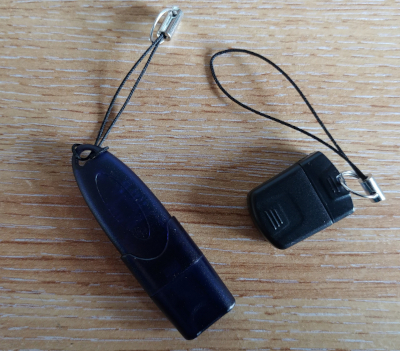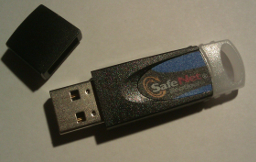Installation of a Licensing Dongle
Jim can be licensed to run using a
dongle on Microsoft Windows, Linux
and Mac OS.
If you purchased Jim with a dongle license, the dongle will arrive in the regular mail.
In order to run Jim, you need to:
- Install Jim on every computer on which you want Jim to run.
Please see the installation instructions for further details (
MS Windows,
Linux,
Mac OS
).
- You will have received a license.txt file by e-mail. Copy this license key
file
license.txt into the Jim install folder.
- Depending on which type of dongle you received, you may need to install the dongle driver
software. Please see below.
There are two types of dongle that can be used to license Jim.
Driverless Dongles
If your dongle looks like either of these:

it is a 'driverless' dongle and is very easy to install.
Driverless Dongle Installation on Windows
Plug the dongle into a USB port of your computer. If Windows says that it is searching for a
driver for the new hardware, then let this process complete. After this, you should be able to run
Jim.
Driverless Dongle Installation on Linux
Although the dongles are driverless under Linux, to give non-root users access to the dongle, you
need to run a bash script before the dongle can be recognised.
Download the bash script inst and save it to the Desktop (or another convenient
location) with the name "inst". Then run the following commands:
cd ~/Desktop
chmod a+x inst
sudo ./inst
If you do not have sudo rights then you must login as root user to run the script.
Do not plug in the dongle until you have run the script. If you have the dongle already plugged
in, then please unplug and plug in the dongle again after running the script.
Driverless Dongle Driver Installation on Mac OS 10.8+ 64-bit Intel Processor Systems
Simply plug into a USB port of your Mac and you will then be able to run Jim.
Safenet Dongles
If your dongle looks like this:

then you will need to install the dongle driver software for
your dongle to work. These dongles were supplied by
SafeNet, Inc, now
acquired by Thales.
Note: Safenet dongles do not work with Mac OS 11 (Big Sur) or later.
When you updgrade a dongle license to Jim version 9, any Safenet dongle
you have will be replaced by a driverless dongle.
Safenet Dongle Driver Installation on Windows
Download the
Sentinel System Driver installer, and then double-click it to run the setup program.
Safenet Dongle Driver Installation on Red Hat
and SuSE Linux
On RPM-based Linux systems, download the
Linux Sentinel driver RPM and then run the following command:
rpm -ivh --force --nodeps sntl-sud-7.5.2-0.i386.rpm
This will install the Sentinel System Driver (USB daemon).
Safenet Dongle Driver Installation on Ubuntu,
Kubuntu,
Debian
and other Debian-derived Linux systems
Download the file sntl-sud_7.5.1.tar and
then extract the files from the tar archive. In a terminal, type:
tar xvf sntl-sud_7.5.1.tar
Then run the following command:
sh sud_install.sh
Safenet Dongle Driver Installation on Mac OS 10.8+ 64-bit Intel Processor
Systems
Note: Safenet dongles do not work with Mac OS 11 (Big Sur) or later.
When you updgrade a dongle license to Jim version 9, any Safenet dongle
you have will be replaced by a driverless dongle.
- Click on Mac OS
Sentinel installer. Select "Save file" and save as "Sentinel_Keys_Protection_Installer.zip".
- Double click to expand, which creates the folder
"Sentinel_Keys_Protection_Installer".
- Open the folder, and the open the sub-folder "English", and double-click on the
Sentinel
Keys Protection Installer package, then follow the instructions to install on your hard
disk.


